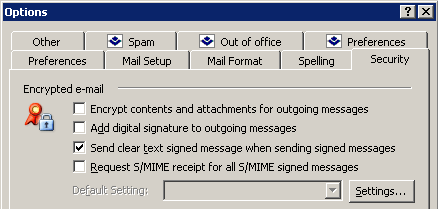For security reasons, Kerio WebMail logs out users automatically after a preset idleness timeout or after the timeout set for the maximal length of connection to the Kerio WebMail interface. By default, the length of inactivity period is set to 2 hours. By default, the maximal length of connection to the Kerio WebMail interface is set for 312 hours. Kerio Connect administrators can change this value.
When any of these timeout expires, clicking on any link or button returns the user to the login page and the user has to log in again.
If any pop-up blocker (pop-up killer) is installed on the computer where Kerio WebMail is running, it is necessary to create an exceptional rule in Kerio WebMail or to connect via secure connections (see chapter 1.2 Authentication to Kerio WebMail). Otherwise, event and task reminders will not work in Kerio WebMail.
If the pop-up blocker is embedded in the web browser, create an exception for Kerio WebMail or disable the pop-up blocker completely.
Size of any outgoing email message (event, task or contact) must not exceed the limit set by Kerio Connect administrator (for detailed information, see the Kerio Connect administrator's guide). Otherwise, the particular message will not be delivered. No limit applies to incoming mail.
After certain period of using, some default folders, such as Deleted items, Junk email, etc., may be duplicated in the Kerio WebMail's folder tree.
This problem occurs under the following circumstances:
besides Kerio WebMail, a user connects to his/her mailbox also via an email client which is not directly supported by Kerio Connect (e.g. MS Outlook Express),
this unsupported email client is not in English,
client applications connects to the server via IMAP.
If the conditions described above are met, the mail client might create its own set of special folders (they cannot be found at the server since their names are in English there). These changes are copied by Kerio WebMail.
In MS Outlook Express, the problem can be removed by renaming the critical folders (Sent Items and Drafts) under :
Click on the particular email account and click .
Select the bottom IMAP folder and change the Sent Items and Drafts folder names (for details, see figure 1.16 Renaming folder names in MS Outlook Express).
Senders who use MS Outlook with the Kerio Outlook Connector (however, this problem can arise even if some obsolete email clients are used) can send digitally signed messages in a format that is not supported by Kerio WebMail. This problem can be solved by allowing sending of digitally-signed email messages in MS Outlook as clear text messages.
If your messages are digitally signed, in MS Outlook check the Send clear text signed message when sending signed messages option under on the Security tab (see figure 1.17 Setting verification of digitally signed messages in MS Outlook). This option provides that also Kerio WebMail users may read the message.
Note
The settings shown here applies to MS Outlook 2003. For other versions of MS Outlook, the settings may differ slightly. In MS Outlook 2007, this setting can be found under .

